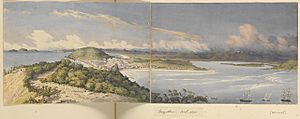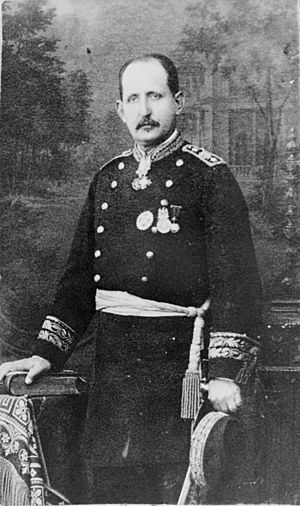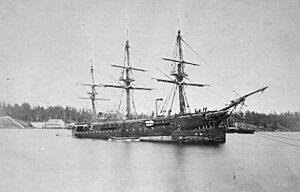Capture of Mazatlán facts for kids
Quick facts for kids Battle of Mazatlán |
|||||||
|---|---|---|---|---|---|---|---|
| Part of the Second French intervention in Mexico | |||||||
 contemporary view of Mazatlán |
|||||||
|
|||||||
| Belligerents | |||||||
| Commanders and leaders | |||||||
| Marlineau des Chenez | Jesus García Morales Gaspar Sanchez Ochoa Marcial Benitez Miguel Quintana Jose Gamboa Cleopas Tagle |
||||||
| Casualties and losses | |||||||
| unknown | 1 dead 5 injured |
||||||
The Capture of Mazatlán was an important victory for Mexico during the Maximilian Affair. Mazatlán was a very important port city on the Pacific coast. It was valuable because it handled trade worth millions of dollars each year.
Contents
First Battle for Mazatlán
When Colonel Gaspar Sanchez Ochoa arrived in Mazatlán, he quickly made the city's northern entrance stronger. This area was near Nevería hill and extended to the old harbor. On the other side, facing the town, he set up his main base on the beach. He also placed some small cannons there.
Soldiers were kept ready in a good spot to the west. This area had three islands close to the old port.
French Attack Begins
On March 28, 1864, the main French warship, La Cordelière, appeared near the center island. It sent signals to other French ships and boats. These boats were getting ready to bring cannons and soldiers to shore. The French ships spread out in a half-circle around the port.
First, all the boats moved forward and fired their cannons as they got closer to the Mexican positions. Six Mexican cannon batteries, led by Captain Marcial Benitez, fired back. Then, some boats moved to the left, and only three boats out of fourteen stayed in front. These three boats landed their troops.
Captain Marcial Benitez stayed on the beach with two cannon batteries to fight the ships. Meanwhile, Colonel Gaspar Sanchez Ochoa took four cannon batteries, led by Captain Jose Gamboa, and two groups of soldiers. He quickly moved to face the French soldiers who had just landed. He ordered his troops to march fast and open fire. After more cannon fire and gunshots, the French soldiers ran back to their boats.
Mexican Victory and an Accident
The victory on land was very important for the Mexicans. However, a sad accident briefly stopped their excitement. Captain Miguel Quintana, an engineer, was in charge of ordering the cannons to fire at the French invaders. He and Lieutenant Cleopas Tagle, also an engineer, wanted to personally load some cannon cartridges.
Under unclear reasons, the cartridges exploded. Captain Quintana was badly hurt by a grenade. Three other gunners and a sergeant were wounded, and one soldier died. Meanwhile, the French boats rowed back to their ships. They carried their dead and wounded soldiers with them.
The battle continued on March 31. The French ship La Cordelière moved closer to the Mexican forts. It raised its war flag and signal fire. Then, it fired a 120-pound bomb into the city. This injured some workers and soldiers.
Colonel Ochoa rode to the shore with the only cannon that could reach far enough. This cannon was commanded by Captain Marcial Benitez. They exchanged shots with La Cordelière for six hours. The French ship became covered in smoke and fire. The French ship's shots were not accurate and did not cause much damage to the forts or the Mexican crew.
Late that night, Governor Jesus García Morales arrived. He watched the fight, along with the British ship Charybdis and the American Navy ship Lancaster. La Cordelière had to fix the damage to its deck. It lowered its war flag and moved away to the nearby Isla del Venado.
Control of Mazatlán

Before the city was taken over, French ships blocked the port starting in mid-April 1864. Inside the Mexican Republican party, several leaders disagreed about who should control the city.
In May, General Plácido Vega and his volunteer soldiers protected Mazatlán. In October 1864, Jesus García Morales, the governor of Nuevo León, and one of his officers, Ramón Corona, both wanted to be in charge of Mazatlán. This led to disagreements between them. Morales even tried to arrest Corona.
On October 10, Ramón Corona was staying in Presidio, a few miles southeast of the city. The next day, he left the fort and moved towards Los Urias, halfway to Mazatlán. He asked Morales to officially give up control to him on October 15. Morales refused and immediately prepared for war against his fellow Mexican officer.
He placed all the port's cannons (48 of them) on the land path into the city. His 500 soldiers faced Corona's 600 foot soldiers and 200 cavalry. Corona also had 1,000 extra soldiers ready.
Corona Takes the City
At 2 a.m., Corona launched an attack from the south, about 1.5 miles from the city center. His army easily broke through the first line of defense. After a very short fight, Morales's soldiers retreated in a disorganized way. Corona claimed the city for himself and arrested Morales. In total, 18 Mexican Republicans were killed and 15 were wounded just before the French forces arrived.
Antonio Rosales, the governor of Sinaloa, arrived in late October. He took control of the city for himself, removing the previous leaders. Seeing this situation, many people in the city preferred the French to take over.
On October 24, three French warships, the Victoire, D'Assas, and the Diamant, left Acapulco. They carried 250 French riflemen, 150 sailors, and 70 Egyptian soldiers. These forces were led by Captain Thomas Louis Le Normant de Kergrist.
Manuel Lozada, an Imperialist officer, approached the town from inland. He waited for the French navy to surround the city. The city began to be emptied, and people fled from the coast.
French Occupation
On November 12, the French naval division reached the port. Commander Rosales met them under a flag of truce. Negotiations started that day. The French gave an ultimatum, demanding surrender by November 13. A second message was sent, threatening that any resistance would lead to fighting. This would also affect neutral ships (mostly American) in the harbor.
Rosales responded by putting the coastal cannons on alert. This meant they could fire on any ship that came within their range. The next day at six o'clock, the French warships started shelling the houses, damaging several of them.
The Mexican commander, with local consuls, sailed to the French flagship. He told the French that they had met the surrender terms the night before. Corona's soldiers had left the city as requested. French troops landed, and Lozada's men (a force of 5000 soldiers) took control of the city. One American citizen was shot. Connections with San Blas and Zacatecas were made. The buying and selling of weapons, and carrying any arms, were forbidden.
General Corona tried to retake the city three times in 1866, but he was not successful. The liberal forces finally got the city back on November 13, 1866. This happened after Lozada's forces left because they were not paid.
See also
 In Spanish: Batalla de Mazatlán (1864) para niños
In Spanish: Batalla de Mazatlán (1864) para niños
- List of battles of the French intervention in Mexico


